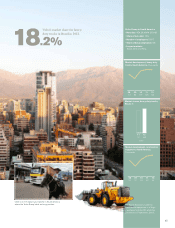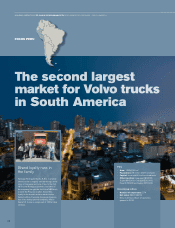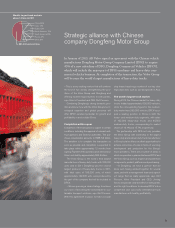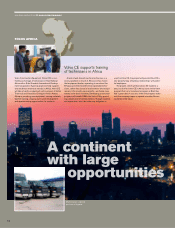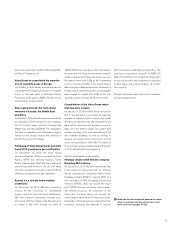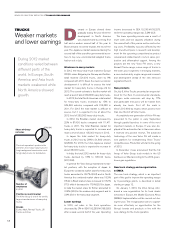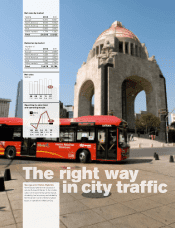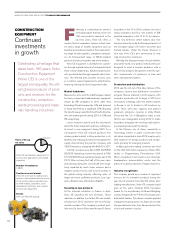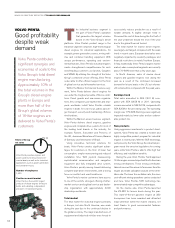Volvo 2012 Annual Report Download - page 58
Download and view the complete annual report
Please find page 58 of the 2012 Volvo annual report below. You can navigate through the pages in the report by either clicking on the pages listed below, or by using the keyword search tool below to find specific information within the annual report.
see how things look in reality – which immediately
makes the situation more complicated.
Without roads, no trucks
If truck sales are to be possible on a large scale,
a functioning road network and an industrial
infrastructure are essential. Other pieces of the
jigsaw include a system for financing, a haulage
tradition and trained staff to service the trucks.
These prerequisites exist primarily in the north-
ern and southern parts of Africa and this is
reflected in the Volvo Group’s delivery figures for
2012. By tradition, Renault Trucks enjoys a
strong position in North Africa, in Algeria in par-
ticular, but it is also represented in many other
African markets. Volvo trucks are also sold in the
north, in Morocco, for example, but the brand is
largest in South Africa. South Africa is also the
most important market for UD Trucks, while
Mack enjoys a special position in Nigeria.
In a conference room in Lundby in Gothenburg,
Lars-Erik Forsbergh is talking about strategy. At
the time of the interview he headed up Group
Trucks Sales & Marketing EMEA’s operations in
Northern Africa and the Middle East, with respon-
sibility for the Volvo, Mack and UD Trucks brands.
Lars-Erik Forsbergh is optimistic about the future.
So optimistic, in fact that the vision for his region is
described as substantial growth in business. He
stresses that the distribution network is going to
be totally decisive.
− We can never be larger than our local importer.
We have to be perfectly synchronized and have the
same vision. Having a good product is not enough.
Our service network must expand so that we can
keep our promises. One method involves deliver-
ing modular workshops in kits. All the importer
needs to do is cast a concrete foundation. After a
couple of weeks, everything is in place. We also
have another product in the shape of a turn-key
permanent workshop which is delivered by a Turkish
company, says Lars-Erik Forsbergh.
Africa is a continent that generates creativity.
One example is Mack’s importer in Nigeria’s largest
city, Lagos, who is putting together truck deals by
gathering hauliers, developers and financiers
around the same conference table – a local form of
total transport solution.
Products for Africa, today and tomorrow
Nigeria can also serve as an illustration of the two
faces of Africa. Outside Lagos, work is in progress
on creating Eko Atlantic – an artificial peninsula
on which a city district as large as Manhattan will
rise from the sea. Three years from now, it is esti-
mated that 25 million people will be living and
working in the region. There are already more than
50 cities in Africa with populations of over one
million and the urbanization process is continuing.
Jan Vandooren, Director Middle East, Africa
and CIS at Volvo Buses, picks up a glossy brochure
to illustrate developments.
− We delivered two Bus Rapid Transport sys-
tems prior to the Football World Cup in South
Africa. This system is without question the trans-
port solution for the mega-cities that are develop-
ing in Africa. The cost of a BRT system corre-
sponds to just 5% of the investment in a traditional
rail-bound system and it can be operational within
a year after a decision is made.
At the same time, the majority of people in
Africa currently live in the countryside, where the
infrastructure is frequently inferior or non-existent.
For Jan Vandooren, this poses a challenge.
In many parts of Africa, buses with engines at the
front are still the order of the day. They have more
ground clearance and can therefore be driven on
roads of poorer quality. In some circumstances, they
may also be easier and less expensive to service and
purchase. Jan Vandooren can see similarities with
the Indian market. There is also a market in Africa
for buses with a European specification, but they
would be best suited to long-distance transport
along the transport corridors that are currently
being constructed in parts of the continent.
The Chinese dominance
The sale of trucks and buses is linked to the devel-
opment of an improved road network and function-
ing towns and cities and Johan Haglund, Vice
Truck deliveries in Africa
2012 2011
Mack 159 387
Renault Trucks 4,258 3,480
UD Trucks 3,658 3,899
Volvo 4 ,117 3,240
FOCUS AFRICA
A GLOBAL GROUP 2012 GROUP PERFORMANCE DEVELOPMENT BY CONTINENT – AFRICA
By tradition, Renault Trucks
enjoys a powerful position
in North Africa, but it is also
represented in many other
African markets.
54



